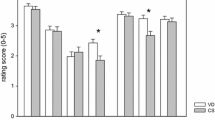Abstract
Purpose
To investigate sociopsychological factors of women undergoing a caesarean section on maternal request (CSMR).
Methods
Twenty-eight women who underwent CSMR and 29 women with vaginal delivery (VD) filled in standardized questionnaires concerning psychological burden (SCL-R 90), fear of childbirth (W-DEQ, STAI), personality structure (HEXACO-Pi-R) and social support (F-SozU) as well as one questionnaire assessing potential factors influencing their mode of delivery.
Results
Women with CSMR were older (36.5 ± 5.4 vs. 30.6 ± 5.2 years; p < 0.001) and suffered more from fear of childbirth (W-DEQ 4.3 ± 0.8 vs. 3.7 ± 1.2; p = 0.041), concerns for their child (W-DEQ 2.0 ± 1.5 vs. 1.3 ± 0.7; p = 0.026) and appraised the birth less negative (W-DEQ 2.0 ± 0.7 vs. 2.7 ± 1.1; p = 0.008). The majority of parturients had chosen their preferred mode of delivery before pregnancy (CS 61% vs. VD 82%, p = 0.328). In the decision-making process for the mode of delivery, the advice of the partner (85 and 90%) played an important role. 82% of the women who delivered via CSMR did not regret the decision for this mode of delivery.
Conclusion
Women who underwent CS had higher fear of childbirth and appraised the birth less negative. The majority did not regret the decision for the CS and would even choose this mode of delivery for their next pregnancy. Although the partner and the physician seem to be important in the decision process for of the mode of delivery, reasons for the choice for CSMR appear to be multifactorial.

Similar content being viewed by others
References
Mylonas I, Friese K (2015) Indications for and risks of elective cesarean section. Dtsch Arztebl Int 112(29–30):489–495. doi:10.3238/arztebl.2015.0489
AWMF Absolute und relative Indikationen zur Sectio caesarea und zur Frage der sogenannten Sectio auf Wunsch (015/054) (2015) http://www.dgggde/leitlinienstellungnahmen/archivierte-leitlinien/federfuehrende-leitlinien-der-dggg/?eID=dam_fronted_push&docID=2083. Accessed 9 June 2015
Karlstrom A, Nystedt A, Hildingsson I (2011) A comparative study of the experience of childbirth between women who preferred and had a caesarean section and women who preferred and had a vaginal birth. Sex Reprod Healthc 2(3):93–99. doi:10.1016/j.srhc.2011.03.002
Garthus-Niegel S, Storksen HT, Torgersen L, Von Soest T, Eberhard-Gran M (2011) The Wijma delivery expectancy/experience questionnaire: a factor analytic study. J Psychosom Obstet Gynaecol 32(3):160–163. doi:10.3109/0167482X.2011.573110
Carrozzino D, Vassend O, Bjorndal F, Pignolo C, Olsen LR, Bech P (2016) A clinimetric analysis of the Hopkins Symptom Checklist (SCL-90-R) in general population studies (Denmark, Norway, and Italy). Nord J Psychiatry 70(5):374–379. doi:10.3109/08039488.2016.1155235
Fydrich T, Sommer G, Brähler E (2007) F-SozU Fragebogen zur Sozialen Unterstützung, vol 1. Hogrefe, Göttingen
Hänze M (2002) Bedürfnis nach Struktur und Furcht vor Festlegung. Z für Differ und Diagn Psychol 23(3):327–338. doi:10.1024//0170-1789.23.3.327
Laux L, Glanzmann P, Schaffner P, Spielberger CD (1981) Das state-trait-angstinventar. Theoretische Grundlagen und Handanweisung. Beltz Test GmbH, Weinheim
Moshagen M, Hilbig BE, Zettler I (2014) Faktorenstruktur, psychometrische Eigenschaften und Messinvarianz der deutschsprachigen Version des 60-Item HEXACO Persönlichkeitsinventars. Diagnostica 60(2):86–97. doi:10.1026/0012-1924/a000112
Gesundheitswesen A (2014) Bundesauswertung zum Erfassungsjahr 2013: Geburtshilfe. http://www.sqg.de/downloads/Bundesauswertungen/2013/bu_Gesamt_16N1-GEBH_2013.pdf. Accessed 5 Feb 2017
Seyyed Kavoosi E, Younessi S, Farhud DD (2015) Screening of fetal chromosome aneuploidies in the first and second trimester of 125,170 Iranian pregnant women. Iran J Public Health 44(6):791–796
Akintayo AA, Ade-Ojo IP, Olagbuji BN, Akin-Akintayo OO, Ogundare OR, Olofinbiyi BA (2014) Cesarean section on maternal request: the viewpoint of expectant women. Arch Gynecol Obstet 289(4):781–785. doi:10.1007/s00404-013-3063-x
Hobson JA, Slade P, Wrench IJ, Power L (2006) Preoperative anxiety and postoperative satisfaction in women undergoing elective caesarean section. Int J Obstet Anesth 15(1):18–23. doi:10.1016/j.ijoa.2005.05.008
Herbst A, Thorngren-Jerneck K (2001) Mode of delivery in breech presentation at term: increased neonatal morbidity with vaginal delivery. Acta Obstet Gynecol Scand 80(8):731–737
Hamama-Raz Y, Sommerfeld E, Ken-Dror D, Lacher R, Ben-Ezra M (2016) The role of intra-personal and inter-personal factors in fear of childbirth: a preliminary study. Psychiatr Q. doi:10.1007/s11126-016-9455-x
Dehghani M, Sharpe L, Khatibi A (2014) Catastrophizing mediates the relationship between fear of pain and preference for elective caesarean section. Eur J Pain 18(4):582–589. doi:10.1002/j.1532-2149.2013.00404.x
Wiklund I, Edman G, Andolf E (2007) Cesarean section on maternal request: reasons for the request, self-estimated health, expectations, experience of birth and signs of depression among first-time mothers. Acta Obstet Gynecol Scand 86(4):451–456. doi:10.1080/00016340701217913
Nieminen K, Stephansson O, Ryding EL (2009) Women’s fear of childbirth and preference for cesarean section: a cross-sectional study at various stages of pregnancy in Sweden. Acta Obstet Gynecol Scand 88(7):807–813. doi:10.1080/00016340902998436
Mould TA, Chong S, Spencer JA, Gallivan S (1996) Women’s involvement with the decision preceding their caesarean section and their degree of satisfaction. Br J Obstet Gynaecol 103(11):1074–1077
Author contributions
PS: data collection, data analysis and manuscript writing; SB: manuscript editing; SL: data analysis and manuscript editing; CS: project development; MS: Project development; and BTP: development, data analysis and manuscript writing.
Author information
Authors and Affiliations
Corresponding author
Ethics declarations
Conflict of interest
All authors declare that they have no conflict of interest.
Ethical approval
The study was approved by the Ethics Committee II of the Medical Faculty Mannheim, Heidelberg University (2013-588N-MA).
Informed consent
Informed consent was obtained from all individual participants included in the study.
Research involving human and animal rights
No animals were involved.
Rights and permissions
About this article
Cite this article
Stützer, P.P., Berlit, S., Lis, S. et al. Elective Caesarean section on maternal request in Germany: factors affecting decision making concerning mode of delivery. Arch Gynecol Obstet 295, 1151–1156 (2017). https://doi.org/10.1007/s00404-017-4349-1
Received:
Accepted:
Published:
Issue Date:
DOI: https://doi.org/10.1007/s00404-017-4349-1




